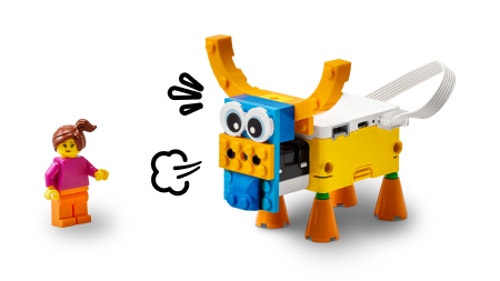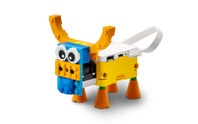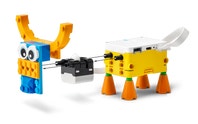Animal Behaviour
Maria sees that African buffalo live in large herds. She wonders why they live in groups rather than on their own.

Prepare
(NOTE: This lesson contains a Part A and a Part B. Both are important to access the full learning of the curriculum. If time is limited, review both parts to choose elements that meet your students’ needs.)
In this lesson, students will build an African water buffalo model using the example images for inspiration. Encourage them to design and build their own idea for a buffalo.
- Science Background - Animal Behaviour: In the simplified model of this lesson, the buffalo use sight to detect predators that are nearby. In the real world, many animals use other senses, such as smell, to detect predators. This helps them notice the predator before it’s close enough to see.
- Build Prior Knowledge - Animal Behaviour: Using your core science materials, share information, images and definitions to build prior knowledge.
- Many kinds of animals, including the African buffalo, live in groups called herds.
- Living in groups often allows animals to share tasks like hunting, finding food and raising young.
- For African buffalo, some herd members watch for predators and warn other herd members of the danger. This helps the group survive by giving it time to escape danger.
- The senses (e.g., sight vs. smell) that animals use to detect predators vary.
- An argument supports a claim or statement about something that happens in nature (e.g., living in groups helps animals survive). It should include evidence like reasons, data like facts and/or a model demonstrating observations.
- Key vocabulary: herd, predator, survive, argument, claim
- Building and Programming Experience: Review the suggestions in the Unit Plan. For this lesson, you may also want to
- Reinforce with the Colour Sensor tutorial in the SPIKE App Start menu.
- Use the Colour Sensor section of the Help>Word Blocks menu in the SPIKE app to provide more support.
- Use the Swamp Boat lesson to build experience using the colour sensor.
- Materials: If you plan to use the Extension activity, collect and distribute several pieces of graphing paper per student.
PART A (45 minutes)
Engage
(Whole Class, 10 minutes)

Introduce the story’s main character(s) and the first challenge: Maria sees that African buffalo live in large herds. She wonders why they live in groups rather than on their own.
THINK – Facilitate a brief discussion about the lesson topic(s), using the story picture if you wish.
- What are some animals that live in herds? (Answers will vary: cows, goats; buffalo, elk and zebras.)
- How does living in a herd help these animals survive? (They can help each other find food, care for the young or warn other herd members of danger.)
- Let’s explore how living in a herd can help animals stay safe from predators.
Distribute a SPIKE Essential Set and a device to each group.
Explore
(Small Groups, 25 minutes)
As students work, consider sharing the examples below as support for building or programming. Clarify that the image(s) show one idea and students should build their own ideas for a grazing buffalo that can detect a predator.
Have students:
- Use the base model to BUILD a grazing buffalo with a colour sensor in its head pointing down toward its food and a predator that the buffalo can detect.
- PROGRAM their model to make a sound when the buffalo sees the colour yellow (representing a predator like a lion).
- Test their model to see if it makes a sound when a yellow LEGO® element is placed under the colour sensor.
Facilitate brainstorming about ways to use LEGO elements to create a buffalo that is looking downward toward its food and create a predator where the buffalo might see it. As needed, clarify that the base model represents a lone animal intent on grazing and the yellow plate is the predator.
Halfway through building time, have students exchange ideas using a familiar classroom routine and then update their models with inspiration from sharing.




Explain
(Whole Class, 10 minutes)
Gather students for sharing.
Have each group use their model to demonstrate and explain:
- How it can detect a predator.
- Why an animal eating grass might not see danger until it is near.
Invite students to share how they changed their model to improve its performance.
Have students keep their models intact for use in Part B.
PART B (45 minutes)
Explain
(Whole Class, 10 minutes)
- Repeat the steps from Part A – Explain to have additional groups demonstrate and explain their learning.
Elaborate
(Whole Class, 25 minutes)
Share background to help students Elaborate:
- The buffalo from Part A was focused on eating and might not see a predator until it was very close.
- In the real world, animals want to notice a predator before it’s too close.
- Some herd members watch for predators and warn the herd while others are eating.
Have students:
- Modify and test their models to complete the next challenge in the app: Change the colour sensor on the animal’s head so that it points forward instead of down.
- Demonstrate that their model can detect an approaching predator (a yellow LEGO® element).
- Describe how well their second model detects predators compared with the first model. (A forward-facing sensor should detect predators at a greater distance than a downward-facing sensor.)
- Make an argument for why living in groups this way might help a herd of African buffalo. (Having a watching animal warn the others gives the herd more time to escape if predators approach.)
As needed, remind students not to block the colour sensor in their rebuilding or it won’t detect a predator.
(5 min) Invite students to share knowledge, ideas or skills that:
- Helped them complete the challenge.
- They learned while building.
Have students clean up the sets and work areas.
Evaluate
(Whole Class, 10 minutes)
- Ask guiding questions to elicit students’ thinking and their decisions while ideating, building and programming.
Observation Checklist
Review the key objectives (Teacher Support box).
Use the checklist to observe students’ progress:
- They make an argument that living in herds helps African buffalo survive.
- They use their model to explain that a watching animal can detect a predator sooner, before it gets too close, than a grazing animal busy eating can.
- They use their model to support the argument that the watching animal helps the herd survive by 1) noticing predators at enough distance for the herd to escape and 2) enabling herd members to eat more safely.
Self-Assessment
Have each student choose the brick that they feel best represents their performance。
- Blue brick: I think I can follow instructions to create a program.
- Yellow brick: I can follow instructions to create a program.
- Green brick: I can follow instructions to create a program and I can help a friend do it too.
Peer Feedback
In their small groups, have your students discuss their experiences working together.
Encourage them to use statements like these:
- I liked it when you…
- I’d like to hear more about how you…
Differentiation
Simplify this lesson by:
- Allowing students to attach the outward-facing colour sensor in Part B to the animal’s body instead of incorporating it into the animal’s head.
Increase the difficulty by: - Having students build, program and test a sensor on “predators” at varying distances or approaching from different directions. At what distances can the buffalo detect a predator? Does the direction matter?
Extension
- Have students write a story about an animal herd that features their models as characters, including the animals that concentrate on eating and the animals that look around for danger. Provide graphing paper and ask students to include a scaled illustration that includes both herd animals and a predator, using units to show logical distances in what the two herd animals notice.
If facilitated, this will extend beyond the 45-minute lesson.
Teacher Support
Students will:
- Build a model to explain the importance of a grazing animal and a watching animal for the animal’s survival.
- Make an argument that living in a group helps animals to defend group members.
- Use their model to support the argument.
(one for every two students)
- LEGO® Education SPIKE™ Essential Set
- Device with the LEGO Education SPIKE App installed
- See Prepare - Materials.
ACSSU030 ACTDEP015 ACTDIP011 ACELY1676 ACELY1682 ACMMG063 ACMMG061
Science (Biological Sciences)
Year 2 Living Things Grow, Change, and Have Offspring:
ACSSU030: "Living things grow, change and have offspring similar to themselves."
Technologies (Design and Technologies)
Years 3 to 4 Designing Solutions:
ACTDEP015: "Generate, develop, and communicate design ideas and decisions using appropriate technical terms and graphical representation techniques."
Technologies (Digital Technologies)
Years 3 and 4 Digital Implementation:
ACTDIP011:” Implement simple digital solutions as visual programs with algorithms involving branching (decisions) and user input”
English (Literacy)
Year 3 Speaking and Listening:
ACELY1676: "Listen to and contribute to conversations and discussions to share information and ideas and negotiate in collaborative situations."
English (Literacy - Language Arts Extension)
Year 3 Texts Creation:
ACELY1682: "Plan, draft and publish imaginative, informative and persuasive texts demonstrating increasing control over text structures and language features and selecting print,and multimodal elements appropriate to the audience and purpose."
Mathematics (Measurement and Geometry)
Year 3 Shape:
ACMMG063: "Make models of three-dimensional objects and describe key features."
ACMMG061: "Measure, order and compare objects using familiar metric units of length, mass and capacity."




